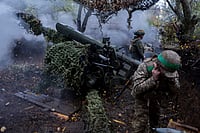Following the massive landslide in Papua New Guinea's isolated Enga province on Friday, in which at least 100 persons are feared dead, rescue services have been racing to reach the villages affected.
A rapid response team consisting of medics and military personnel managed to reach the isolated site of the landslide, BBC cited humanitarian agency Care Australia as saying.
The landslide struck the Enga province, about 600 kilometers (370 miles) northwest of the capital, Port Moresby, at roughly 3 am on Friday, burying a village in the remote and mountainous part of PNG.
Though residents of the village estimated a death toll of over 100, officials have not yet confirmed this figure.
Officials noted that the damage caused to the main roads and the difficult terrain is making rescue operations tough, in addition to the blocked highway access. This leaves helicopter route as the only possible access to the area.
An Enga Province MP, Amos Akem, told the Guardian newspaper that as per ground reports, "the landslide buried more than 300 people and 1,182 houses".
Serhan Aktoprak, the chief of the International Organisation for Migration's (IOM) mission in Papua New Guinea, said that the landslide struck the Yambali village, which is about two hours' drive from Enga provincial capital of Wabag.
“The land still continues sliding, therefore it makes it very difficult to operate on,” he said, citing reports from IOM staff and others deployed from the provincial capital to the affected village.
The area affected covered the size of three to four football fields, Aktoprak told The Associated Press, adding that the village is home to 3,895 people.
"Given the scale of the disaster," he said he feared that the death told could be higher than the original estimate of about 100.
Aktoprak said that there is water inaccessibility in the area, along with power lines being down. The villagers are struggling to access food, he said. "Immediate needs are shelter, other non-food items (like) blankets and bedsheets, food and drinking water,” he added.
Meanwhile, a resident from a nearby village said that there were no houses left on the scene of the landslide.
He said it was all "just flat with soil", Australian Broadcasting Corp (ABC) news reported. The resident -- Dominic Lau -- said other than rocks and soil, there was nothing, no people, no houses.
As many as "six villages" have been affected by the "unprecedented natural disaster", Enga's Governor Peter Ipatas told AFP.
Prime Minister James Marape on Friday had said that authorities were attending to the situation. "I am yet to be fully briefed on the situation. However, I extend my heartfelt condolences to the families of those who lost their lives in the landslide disaster in the early hours of this morning,” he said in a statement.
“We are sending in disaster officials, PNG Defense Force, and the Department of Works and Highways to... start relief work, recovery of bodies, and reconstruction of infrastructure,” Marape said.
PNG's neighbour and the most generous provider of foreign aid, Australia, said the government stood ready to help.
Australian Prime Minister Anthony Albanese said, "All Australians grieve for our brothers and sisters in Papua New Guinea after the terrible landslide. We send our deepest condolences to those affected. Australia stands ready to assist."
Australian Foreign Minister Penny Wong posted on social media and said, "We send our heartfelt sympathies to the people of PNG following the landslide."
“The loss of life and destruction is devastating. As friends and partners, Australia stands ready to assist in relief and recovery efforts," she added.
Papua New Guinea is a diverse, developing nation of mostly subsistence farmers with 800 languages. There are few roads outside the larger cities.
With 10 million people, it is also the most populous South Pacific nation after Australia, which is home to around 27 million.



























